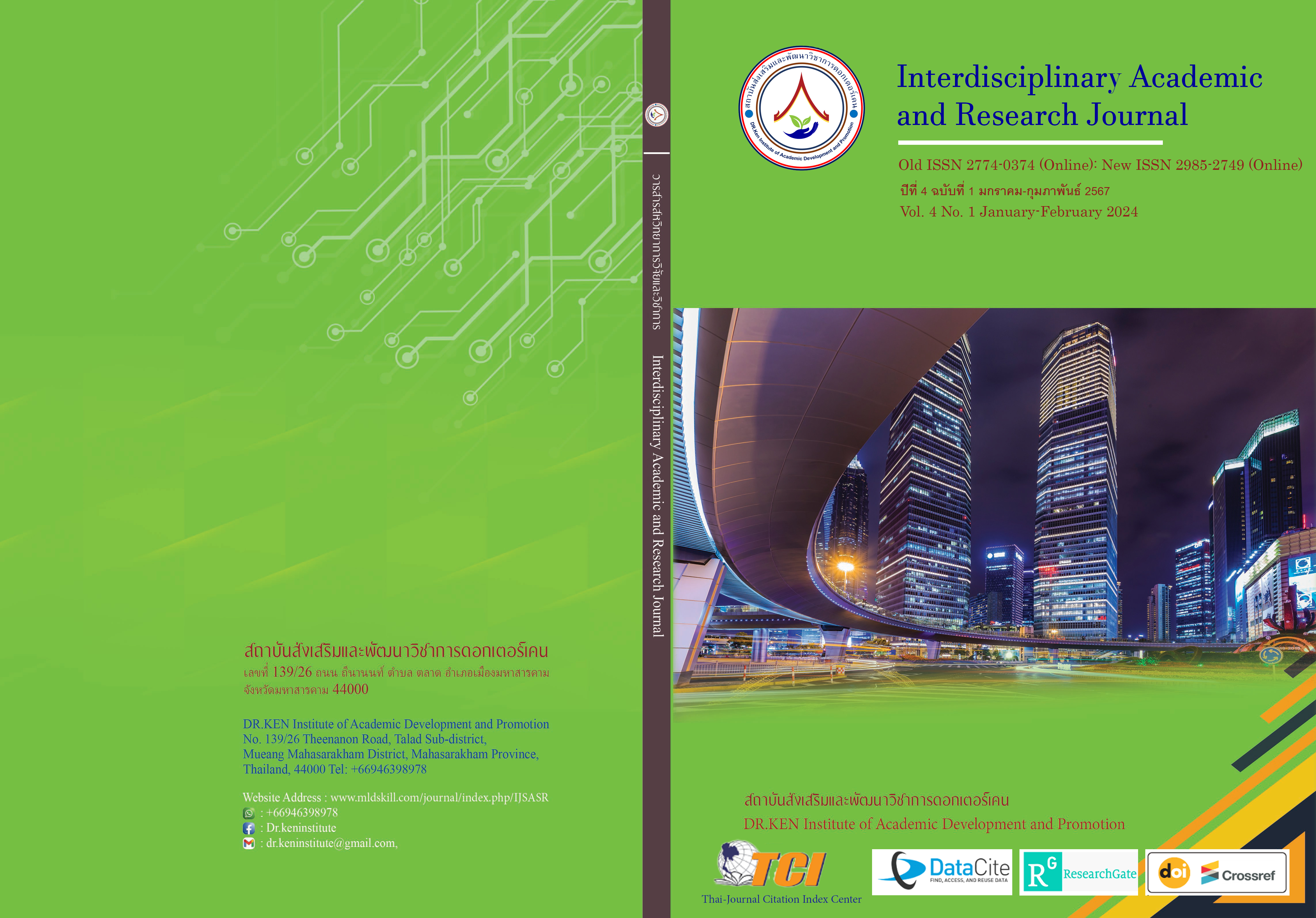Developing a Cooperative Learning Teaching Model Computational Science Course Using Electronic Books
DOI:
https://doi.org/10.60027/iarj.2024.273180Keywords:
Collaborative Teaching Style;, Electronic Books; , Phibun Mangsahan SchoolAbstract
Background and Aims: Organizing learning according to the collaborative learning approach is the direct duty of the teacher in creating knowledge, and understanding to create practical skills in organizing the learning process, or promoting the learning process so that students can learn by themselves by actually doing and seeking knowledge knowingly. Thus, the aims of this study are 1) to develop a collaborative teaching model for computational science subjects; using electronic books. And 2) To study the results of using a collaborative teaching model for computational science subjects using electronic books.
Methodology: The sample group includes Mathayom 2/2 students at Phibun Mangsahan School, semester 2, academic year 2021, totaling 40 people which was obtained using the cluster random sampling method. The tools used in the research include 1) a collaborative teaching model for computational science subjects using electronic books. 2) management plans. 3) electronic book computational science course. 4) academic achievement test computational science course. 5) measurement of satisfaction with electronic books. 6) questionnaire of teachers' opinions on the cooperative teaching model for computational science subjects using electronic books. Statistics used in data analysis are percentage, mean, standard deviation, and t-test statistics.
Results: The results of the study found that (1) Developing a collaborative teaching model for computational science subjects. Using electronic books as follows; 1) Teachers need to organize teaching and learning activities in the computational science subject. Overall, it is at the highest level. 2) Students have a desire to organize activities. Overall teaching and learning is at a high level. 3) Experts have opinions about the appropriateness of the cooperative learning teaching model. Computational science course using electronic books Overall, it is seen that it is at the highest level of suitability. (2) Results of using the collaborative teaching model to learn the subject of computational science. using electronic books; 1) Results of finding the efficiency of the collaborative teaching model for computational science subjects. Using electronic books, the value is equal to 82.21/82.83. 2) Comparative results of the academic achievement of students who studied with the cooperative teaching model in the subject of computational science using electronic books After studying was significantly higher than before studying at the .05 level. 3) Results of the study of satisfaction with electronic books Overall, it is at the highest level.
Conclusion: Developing a collaborative teaching model for computational science using e-books is very appropriate for teachers, students, and experts. Moreover, the use of this teaching model has a positive effect in increasing the learning efficiency of students in the computational science subject and keeping their satisfaction with e-books at the highest level.
References
จารุขจิต ชาวชาติ. (2563). การพัฒนารูปแบบการสอนบนเว็บตามแนวคิดการเรียนรู้ร่วมมือกัน รายวิชาการงานอาชีพ. วารสารการบริหารนิติบุคคลและนวัตกรรมท้องถิ่น, 8 (11), 119-128.
ทรงศักดิ์ สองสนิท และคณะ. (2562). การพัฒนารูปแบบการเรียนการสอนแบบร่วมมือโดยอาศัยพื้นฐานการเรียนรู้แบบโครงงานผ่านระบบเครือข่ายคอมพิวเตอร์. วารสารมหาวิทยาลัยราชภัฏมหาสารคาม, 3(3), 179-188.
บรรพต วงศ์ทองเจริญ และคณะ. (2565). การพัฒนาหนังสืออิเล็กทรอนิกส์บนเว็บ เรื่อง วิทยาการคำนวณ สำหรับนักเรียนชั้นมัธยมศึกษาปีที่ 1 โรงเรียนวัดโพธิ์ทอง. วารสารครุศาสตร์ มหาวิทยาลัยราชภัฏบุรีรัมย์, 2(1), 65-72.
บุญชม ศรีสะอาด. (2553). การวิจัยเบื้องต้น. พิมพ์ครั้งที่ 8. กรุงเทพฯ : สุวีริยาสาส์น.
เบญญาลักษณ์ รวยเรืองรุ่ง. (2563). การพัฒนารูปแบบการสอนตามแนวคิดทฤษฎีแบบร่วมมือกันเรียนรู้ รายวิชาคอมพิวเตอร์. วารสารการบริหารนิติบุคคลและนวัตกรรมท้องถิ่น, 7 (2), 110-121.
ปาณิสรา หาดขุนทด และ ธนากร แสงกุดเลาะ. (2565). การสร้างสื่อการเรียนรู้แบบมัลติมีเดีย รายวิชาวิทยาการคำนวณระดับประถมศึกษาสำหรับโรงเรียนขนาดเล็กที่ขาดแคลนครู. วารสารการพัฒนาชุมชนและคุณภาพชีวิต, 10(3), 302-313.
ปิยนันท์ ปานนิ่ม. (2559). การพัฒนารูปแบบการเรียนการสอนบนเว็บแบบผสมผสานด้วยการเรียนการสอนแบบร่วมมือ. วารสารวิจัยและพัฒนาวไลยอลงกรณ์ ในพระบรมราชูปถัมภ์, 11 (2), 121-129.
พิณสุดา สิริธรังศรี. (2552). รายงานการวิจัย เรื่อง ภาพการศึกษาไทยในอนาคต 10 –20 ปี. กรุงเทพฯ : พิมพ์ดีการพิมพ์.
พิพัฒนพงศ์ พลเยี่ยม. การพัฒนารูปแบบการสอนตามทฤษฎีการสร้างความรู้เพื่อส่งเสริมความสามารถในการสร้างความรู้ รายวิชาคอมพิวเตอร์ โดยใช้หนังสืออิเล็กทรอนิกส์. วารสารสาระคาม, 10(2), 83-116.
ไพฑูรย์ ศรีฟ้า. (2551). E-Book หนังสือพูดได้. พิมพ์ครั้งที่ 2. กรุงเทพฯ : ฐานบุ๊คส์.
รัชพล ครองยุติ. (2564). การพัฒนารูปแบบการสอนบทเรียนออนไลน์ รายวิชาวิทยาการคำนวณ ตามทฤษฎีการเรียนรู้แบบร่วมมือ. วารสารการบริหารนิติบุคคลและนวัตกรรมท้องถิ่น, 8 (11), 87-105.
วิทยากร เชียงกูล. (2553). แนวคิดการปฏิรูปการศึกษา. Retrieved on 1 September 2023 from: http://witayakoronclub.wordpress.coom/.
Krejcie, R.V., & Morgan, D.W. (1970). Determining Sample Size for Research Activities. Educational and Psychological Measurement, 30(3), 607 – 610.
Downloads
Published
How to Cite
Issue
Section
License
Copyright (c) 2024 Ratree Boonkeang

This work is licensed under a Creative Commons Attribution-NonCommercial-NoDerivatives 4.0 International License.
Copyright on any article in the Interdisciplinary Academic and Research Journal is retained by the author(s) under the under the Creative Commons Attribution-NonCommercial-NoDerivatives 4.0 International License. Permission to use text, content, images, etc. of publication. Any user to read, download, copy, distribute, print, search, or link to the full texts of articles, crawl them for indexing, pass them as data to software, or use them for any other lawful purpose. But do not use it for commercial use or with the intent to benefit any business.
















.png)


